Lisa Niver's Blog: We Said Go Travel, page 485
July 17, 2013
Spain: Where my Soul Dwells Happiest
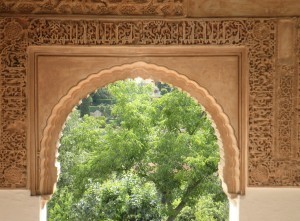 The scent of warm pine filling the air; dusty ground littered with browned needles that I scraped with sandal-clad toes as I rose and fell on the yellow painted metal see-saw; parents sat near-by with a jug of sangria as lizards skittered amongst the chairs.
The scent of warm pine filling the air; dusty ground littered with browned needles that I scraped with sandal-clad toes as I rose and fell on the yellow painted metal see-saw; parents sat near-by with a jug of sangria as lizards skittered amongst the chairs.
They say that smell is one of the stronger senses for recalling memories. Every time I stepped off a plane in Spain and the smell of jet fuel mingled with that of warmed pines, the memory rushed back. I have been in love with Spain since the age of three – with the small coves where I roamed the beaches in search of pretty shells or sat in rock-pools commanding mussels and sea-anemone in my private kingdom – and my travels invariably took me back there.
Spain was not particularly free in 1973: Franco still dictated the lives of Spaniards. With his death came a more open Spain, one that northern Europeans flocked to for the sun, food and slow, welcoming pace of life. I returned to her shores at every opportunity, to a country where the young me, free from the worries and constraints of adult-life, had roamed. Then came my chance, and I grabbed it with both hands.
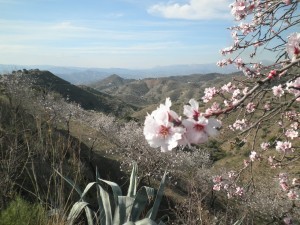 Forty, and tired of the treadmill of everyday life, I had the opportunity to take a year-long sabbatical. I moved to Spain, my belongings in storage in England, my two dogs and the necessary accoutrements of life loaded into the car. I drove from the centre of England, and the length of France and Spain, to make my home in the Andalucían mountains; to embrace the feeling of liberty that Spain afforded me.
Forty, and tired of the treadmill of everyday life, I had the opportunity to take a year-long sabbatical. I moved to Spain, my belongings in storage in England, my two dogs and the necessary accoutrements of life loaded into the car. I drove from the centre of England, and the length of France and Spain, to make my home in the Andalucían mountains; to embrace the feeling of liberty that Spain afforded me.
From my mountain-side house where eagles and vultures cast long shadows over the valleys, crevices and dusty tracks, I explored. I explored my inner feelings, dwelling in my house of solitude. I explored the Moorish splendour of Granada, tracing the carved words of a language I do not understand with my fingertips, but whose sentiment felt clear to me. I let my thoughts run free in the cool, quiet patios of Córdoba where water glistened as it bubbled from spouts and filled the channels below. My spirit soured, the duende burned within me, as I watched and listened to Flamenco in the orange-filled piazzas of Seville. In the dark interiors of cathedrals and chapels, as the heavy, cloying incense spiralled towards Mudejar carved ceilings, I lolled in Spain’s warm embrace.
Climbing higher up my mountain, sitting on a soft bed of old pine needles as the dogs snuffled around in search of the wild boar whose scent lingered in the short spikey bushes, I looked across the water to North Africa. A land of adventure and discovery beckoned me to join her. I’ve tasted her culture, infused with the Spanish in Andalucía’s dishes – the warmth of the spices mixed with the olives and goat that can be found on the scrubby foothills. But Spain holds me close, whilst giving me space.
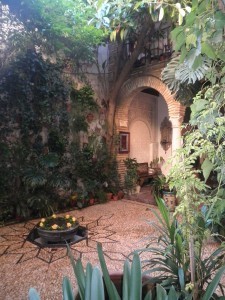 My one year turned to three before the call of a passion, greater than even Spain inspires, pulled me from her shores. It was not to Africa that I turned but Italy; from the mountains and coastline of Andalucía, to the flatlands of Polesine. I had left England, my home country, without a backward glance; no pangs of regret. I left Spain with deep sorrow despite the happy circumstances of my departure. Spain is where my soul dwells happiest – it is where I feel free – I will return.
My one year turned to three before the call of a passion, greater than even Spain inspires, pulled me from her shores. It was not to Africa that I turned but Italy; from the mountains and coastline of Andalucía, to the flatlands of Polesine. I had left England, my home country, without a backward glance; no pangs of regret. I left Spain with deep sorrow despite the happy circumstances of my departure. Spain is where my soul dwells happiest – it is where I feel free – I will return.
About the Author: Deborah Cater is a travel writer, reviewer and blogger. She focuses her travels mainly within Europe, “it is one continent with a multitude of cultures and languages, yet histories that are interwoven tightly together.” Find Debra on her website, Facebook or Twitter @DeborahCater.
The post Spain: Where my Soul Dwells Happiest appeared first on We Said Go Travel.
Shackles Released in Sudan
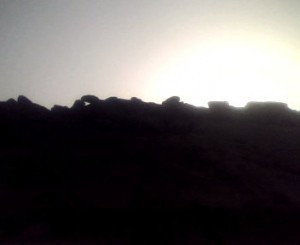 On the day I left Philadelphia, I was consumed with stress and grief. So many things had happened to me and the children over the past three years. My mind could no longer comprehend and my heart was unwilling to be patient any longer. In fact, it no longer had the ability to withstand the constant lack of respect. I had been stripped.
On the day I left Philadelphia, I was consumed with stress and grief. So many things had happened to me and the children over the past three years. My mind could no longer comprehend and my heart was unwilling to be patient any longer. In fact, it no longer had the ability to withstand the constant lack of respect. I had been stripped.
For the past three years I sat and contemplated day in and day out. I could look at our relationship and see everything that was wrong with it. What I could not understand is why I was still there.
Love had been squeezed out of my heart, so this was not a contributing factor. I kept saying to myself that I was staying for the children; boys who needed to become men. This is what I told myself. I was a product of divorce and I knew what it felt like to want my father. However, it was more to it than that. Somewhere along the way, I stopped believing that I deserved to be happy. This is the real reason I stayed.
I really don’t think my mind was settled on divorce at that moment; but I knew I had to get far away. He was toxic and everything in his life was too. At t his rate, I would have lost my mind and my children too. Receiving a job offer to teach in Sudan came in the knick of time.
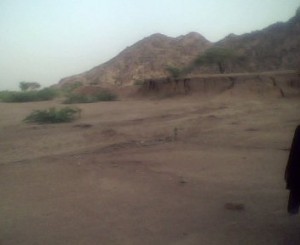 I had never really heard anything positive about Sudan in the media so my expectations were blurred by the unknown and the negative images of the media. Once I arrived, a sense of peace fell over me. I felt safe. It was so different from the urban backdrop of Philadelphia. Everyone was so calm. They seemed so functional.
I had never really heard anything positive about Sudan in the media so my expectations were blurred by the unknown and the negative images of the media. Once I arrived, a sense of peace fell over me. I felt safe. It was so different from the urban backdrop of Philadelphia. Everyone was so calm. They seemed so functional.
Over a period of 3 1/3 years, I went through a transformation that changed my life forever. I had a good job, lovely neighbors, and a secure environment. The boys played freely and were able to establish good relationships. The best thing of all is that I was doing everything alone. I felt empowered. I received absolutely no assistance from my children’s father. Every single thing we had came from my efforts and the help from my Creator.
Not only did I begin to feel I could be happy again; I was happy once again. It had been a long time. True happiness had not been a part of my life for over 13 years. The only thing I could see that was of any value was my children and the effort I put into rearing them.
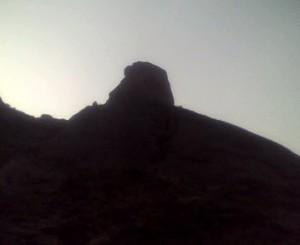 I remember sitting up one night contemplating. I reflected on my life back in America. I accepted the reality of all that had happened in my marriage. I embraced it and I repented for it. I repented for allowing myself to be oppressed. I was created for greatness but I had allowed myself to be treated less than I was worth. In a relationship, no one can be oppressed without a certain amount of consent from the other and for this I repented. I was not created for that purpose.
I remember sitting up one night contemplating. I reflected on my life back in America. I accepted the reality of all that had happened in my marriage. I embraced it and I repented for it. I repented for allowing myself to be oppressed. I was created for greatness but I had allowed myself to be treated less than I was worth. In a relationship, no one can be oppressed without a certain amount of consent from the other and for this I repented. I was not created for that purpose.
Visiting Kassala, Sudan was monumental. I got a chance to do something I have wanted to do all of my life; go mountain climbing. I arrived late afternoon. The foot of the mountains had such a silent beauty that I could never explain it. To the right of me were the mountains, to the left was open desert, and in the distance I could see another mountain chain. It was explained to me that on the other side of those mountains was the country of Eritrea and if I climbed a small way up the mountains I could see even more.
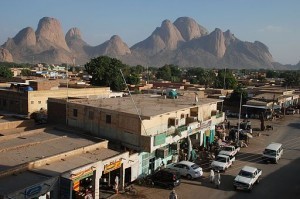 Some of my students started running up the side of the mountain and I ran after them. It felt so liberating. When I got about half way up the mountain, I stopped, turned around, and looked at the scenery. Tears came to my eyes. It was the most beautiful thing I had ever seen. I watched a caravan of camels go by and some Bedouin children playing in the sand.
Some of my students started running up the side of the mountain and I ran after them. It felt so liberating. When I got about half way up the mountain, I stopped, turned around, and looked at the scenery. Tears came to my eyes. It was the most beautiful thing I had ever seen. I watched a caravan of camels go by and some Bedouin children playing in the sand.
I felt free, uninhibited. Then I looked over to the other mountain chain; the one forming a natural border between two counties. From this altitude it did not seem like a barrier between two places, but rather a peaceful giant sleeping unmolested, undisturbed.
In order to leave the familiar and experience something new, all I had to do was crossover. All the negativity held in my soul, al the heartache, bitterness, low self-esteem, and felling of rejections were released that day. The shackles fell and I crossed over, leaving it all behind. I was free.
About the Author: Fatimah Abdulmalik is a freelance writer and editor originally from America. She has spent the last twenty years traveling and living abroad; sharing her knowledge of the English language and writing about her experiences. She likes to write about acculturation, education and green living. You can follow her on twitter, facebook, and Google+.
The post Shackles Released in Sudan appeared first on We Said Go Travel.
Italy: Finding Freedom In Footprints
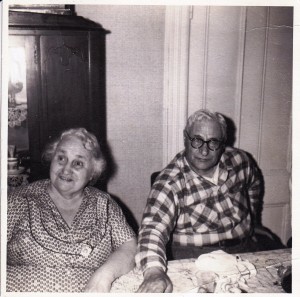 Finding Freedom In My Grandparents’ Footprints
Finding Freedom In My Grandparents’ Footprints
In the summer of 1912 a young couple, Sabato and Palma, boarded a mule cart in their southern Italian town of Vallo della Lucania for the day-long journey to Salerno. From there a train took them to Naples, where they boarded a ship for a two-week ocean voyage that ended in New York Harbor.
Not knowing if they would ever return, Sabato and Palma left behind their families and friends in search of the uncertain opportunities and freedom in America. The journey that began in Vallo della Lucania over one hundred years ago has come full circle.
Sabato and Palma were my grandparents (nonni in Italian) and, like millions of other Italian-American kids, I understood very little about how and why they came to America. That is until I found myself living and working in Naples in 1974. Stepping off the plane, my first thoughts were of my grandparents and how they must have felt stepping onto American soil for the first time. Suddenly I was overcome with a new sense of appreciation and respect for my grandparents and the millions of Italian immigrants who sought better lives for themselves and their descendants. They came seeking freedom.
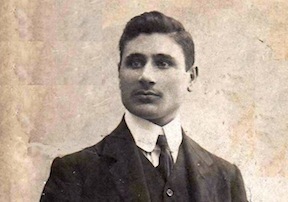 Within weeks my wife joined me; she’s also Italian-American and all of her grandparents had made the same journey. We have returned to Italy many times in the past thirty-eight years to explore what our lives might have been like had our eight grandparents remained in Italy.
Within weeks my wife joined me; she’s also Italian-American and all of her grandparents had made the same journey. We have returned to Italy many times in the past thirty-eight years to explore what our lives might have been like had our eight grandparents remained in Italy.
In the beginning we lived and worked in Pozzuoli (near Naples) where we struggled with the language, customs and everyday challenges. Like our grandparents when they arrived in America we started with almost nothing. Our limited resources forced us to prioritize our needs and taught us what was important. We immersed ourselves into the Neapolitan culture, language and life style which also freed us from the inconsequential aspects of life in America. We learned to live like Italians.
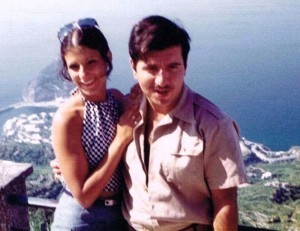 Every day in Pozzuoli was, to say the least, an adventure. Thanks to some neighbors, we learned how and where to shop. There were no supermarkets, only the small, local shops where we became friends the owners. In time, they shared the personal stories of their family businesses, relatives who immigrated to America and, best of all, their recipes. Soon we were being invited into their homes to celebrate birthdays, anniversaries and christenings.
Every day in Pozzuoli was, to say the least, an adventure. Thanks to some neighbors, we learned how and where to shop. There were no supermarkets, only the small, local shops where we became friends the owners. In time, they shared the personal stories of their family businesses, relatives who immigrated to America and, best of all, their recipes. Soon we were being invited into their homes to celebrate birthdays, anniversaries and christenings.
With every event our language skills improved and our insights into our grandparents’ lives began to emerge. A sense of who we were and where we came from evolved – we began to “fit in” and experience a new kind of freedom. This was the life we might have had if our grandparents remained in Italy.
Life was not perfect and we made our share of mistakes along the way. Learning to drive around Napoli can only be described as an essential survival skill. Local drivers ignored traffic lights, stop signs and lane markings. What were normally two-way streets during the winter became one-way streets (without notice) in the summer. We also learned that, when involved in a minor traffic accident in Napoli, you and the other driver first go to the nearest café for a coffee and chat to get acquainted before exchanging insurance information. And then there’s the parking – an exercise in chaos throughout Italy which has only become more difficult as Italian cars have gotten larger. The ultimate test of skill and courage is driving the narrow road on the Amalfi Coast where one slight miscalculation will have you crashing into a big bus or plummeting over the edge and into the rocky surf below. It’s all part of the fun.
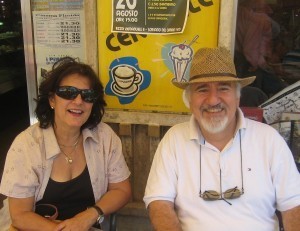 In 1999 our travels took us to my wife’s ancestral village in Calabria and to a small house that belonged to her grandmother. For twelve summers we returned with our son, where he walked in the footprints of his ancestors and looked into faces that looked just like us. There he became friends with the children across the street. Although they didn’t speak a common language, they all managed to communicate. Watching them from the balcony above, it occurred to me that these two families have been close neighbors for centuries. Today our son is an adult and, thanks to the Internet, he and his Italian childhood friends have continued that long relationship.
In 1999 our travels took us to my wife’s ancestral village in Calabria and to a small house that belonged to her grandmother. For twelve summers we returned with our son, where he walked in the footprints of his ancestors and looked into faces that looked just like us. There he became friends with the children across the street. Although they didn’t speak a common language, they all managed to communicate. Watching them from the balcony above, it occurred to me that these two families have been close neighbors for centuries. Today our son is an adult and, thanks to the Internet, he and his Italian childhood friends have continued that long relationship.
I don’t think our grandparents could ever have imagined this for me. They left Italy not knowing that their grandchildren would return. Yet here I am feeling free and as much at home here in Italy as in America. Free to walk the hills and the terraced vineyards and the streets that our ancestors knew so well. It’s like reaching back 100 years and holding hands with my grandparents…grazie, Nonni.
About the Author: Bill Sansone is an Italian-American who grew up near New York City and studied architecture at Virginia Tech, where he met his wife, Carol. On and off since 1973 they have lived, worked and traveled independently throughout Italy studying the regional cultures, food, history and language. Find more of their experiences at LivingItalian Facebook.
The post Italy: Finding Freedom In Footprints appeared first on We Said Go Travel.
July 16, 2013
Becoming the Mask: New Orleans, Myth and Masquerade
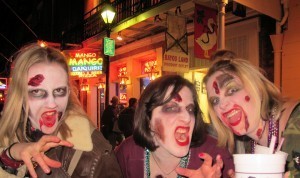 It’s early June and I am sitting pretty in my economy class seat, trying to hold back a grin. As my United Airlines flight descends towards New Orleans, I see the familiar brown, flat surface of Lake Ponchartrain. This is the same lake whose waters swallowed so many of the city’s neighbourhoods in 2005 during Hurricane Katrina.
It’s early June and I am sitting pretty in my economy class seat, trying to hold back a grin. As my United Airlines flight descends towards New Orleans, I see the familiar brown, flat surface of Lake Ponchartrain. This is the same lake whose waters swallowed so many of the city’s neighbourhoods in 2005 during Hurricane Katrina.
I breathe a sigh of contentment when I step off the airplane and feel the Louisiana humidity envelop me: after living in Australia for a year, I am elated to be here. New Orleans has always been a special place for me. This is my seventh visit.
New Orleans is a city of many contradictions, and it is these contradictions which have so firmly wrapped their fingers around my imagination. On the one hand, there are the colourful buildings of the French Quarter and the year-round Mardi Gras atmosphere. Yet the sunny surface of New Orleans’ party culture is juxtaposed with dark motifs of cemeteries, Voodoo, ghosts and death. The Disney quality of Bourbon Street is countered by a multiplicity of authentic musical genres and cultural traditions, most of which cannot be found elsewhere in the United States.
In recent years, New Orleans has experienced significant upheaval at the hands of Hurricane Katrina and the BP oil spill. This is not new to New Orleans, as it has always had a turbulent past. Yet its hardships never extinguish the collective spirit.
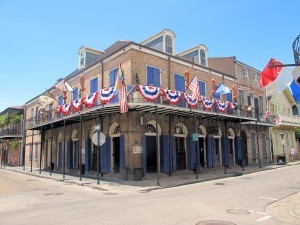 There is a continuity of past and present here that is so tangible, so potently concrete that you can taste it in the air. It feels like voices from days long ago are whispering just around the corner. Coming here is like plugging into a socket of powerful, otherworldly energy. The history is shrouded in both myth and masquerade, and this gives me an extraordinary child-like sense that all things are possible. This is the place where my friends and I eschew conventions of normality, and embrace the city’s carefree Mardi Gras attitude.
There is a continuity of past and present here that is so tangible, so potently concrete that you can taste it in the air. It feels like voices from days long ago are whispering just around the corner. Coming here is like plugging into a socket of powerful, otherworldly energy. The history is shrouded in both myth and masquerade, and this gives me an extraordinary child-like sense that all things are possible. This is the place where my friends and I eschew conventions of normality, and embrace the city’s carefree Mardi Gras attitude.
After a half hour taxi ride, lunch and a stroll by the Mississippi, I eagerly anticipate what the evening holds in store for us. It will be our inaugural night out in the French Quarter, and we will engage in what has now become a tradition for my friends and I. In our hotel room, we patiently apply layers of latex, eye shadow and blood gel: the transformation is complete. We now honour the city’s spooky myths by becoming a horde of shambling undead zombies.
We exit our hotel on Toulouse Street and shamble over to Bourbon, letting out a few groans. I pretend to chew on my friend’s arm. We are a unique sight to behold: a group of thirty-somethings who have totally suspended their disbelief and embraced the spontaneous carnival atmosphere of New Orleans. We stagger down Bourbon, our limbs moving stiffly to mimic the effects of rigor mortis.
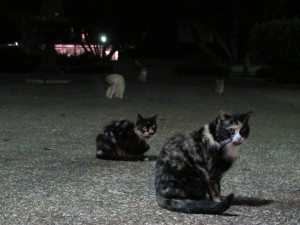 Even at night, New Orleans is hot, so our zombie makeup gets itchy. We stop for a beer or two and growl at passers-by. The group shuffles past Jackson Square where I take photos of its population of feral cats. We continue towards Jean Lafitte’s Blacksmith Shop, our favourite bar. On the way, we encounter two haunted tour groups, who give us a round of applause for our “performance.”
Even at night, New Orleans is hot, so our zombie makeup gets itchy. We stop for a beer or two and growl at passers-by. The group shuffles past Jackson Square where I take photos of its population of feral cats. We continue towards Jean Lafitte’s Blacksmith Shop, our favourite bar. On the way, we encounter two haunted tour groups, who give us a round of applause for our “performance.”
In the city of perpetual Mardi Gras, it is completely and 100% socially acceptable to live out your fantasies in the streets. This is not my first time playing dress-up: I have in the past walked around as a devil, a pirate and in some crazy outfits too bizarre to describe. Engaging in the masquerade is not just about wearing a mask, but rather about becoming the mask, if only for a time. As adults, for a few brief days, we get to become children again, freed by imagination and living in a world of make believe. Displays of creativity and fantasy in New Orleans are normalized and accepted.
All of us find something in New Orleans that we cannot find anywhere else. Here is a place where we are truly free to be ourselves in a way that we cannot at home. While New Orleans is indeed plagued by a myriad of social and economic problems, it remains dichotomous. Where there are flaws, there is also deep beauty and remarkable resilience. Those who know New Orleans cannot help but love it. With all of its flaws and strengths, it is a perfect metaphor for humanity.
After a few hours of wandering, our voices hoarse from moaning, we head back to our hotel, tired from our long day. I look forward to the next, knowing that in New Orleans, the masquerade is a daily reality, and that we are only limited by our imaginations.
About the Author: Suze Tkachuk is a Canadian writer, blogger and traveling foodie. Since 2002, she has visited over 35 countries. She is active in the Twitter travel community and publishes a travel blog, Batsuze Geographic, as her alter-ego Suze von Zombie.
The post Becoming the Mask: New Orleans, Myth and Masquerade appeared first on We Said Go Travel.
Mauritius: Somewhere on the seaside
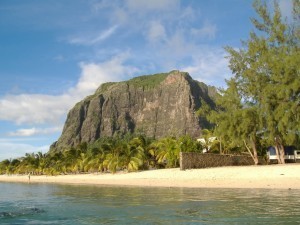 How far do you have to go to find freedom? In my case, I flew more than six thousand miles to my husband’s native country, Mauritius. During three weeks, he made me discover the people, the culture and the magnificent landscapes of this small island. Mauritius is not only a sandy beach as you see in travel brochures. Every place in the country has a history, if you bother looking for it.
How far do you have to go to find freedom? In my case, I flew more than six thousand miles to my husband’s native country, Mauritius. During three weeks, he made me discover the people, the culture and the magnificent landscapes of this small island. Mauritius is not only a sandy beach as you see in travel brochures. Every place in the country has a history, if you bother looking for it.
One afternoon, we drove down the Chamarelle mountain on the west of the island, and stopped at this very small beach situated between two hotels. It was quite secluded and you wouldn’t know it’s there unless you’re a local. I decided to go for a swim and as I was in the water, I turned around. That’s when I saw it. This gigantic mountain was standing there, looking right down at me. The view was absolutely breathtaking. I suddenly felt very small and I had the strange feeling that this place had a special history. When I came out, I asked my husband and his family to tell me the story of The Morne mountain.
During the French domination, many slaves, mainly from Africa, were brought to Mauritius to work on the fields and on construction sites. They were very badly treated by their masters, were tortured and endured corporal punishment.
The story says that the maroon slaves (the ones who managed to escape), found shelter in the Morne mountain because it wasn’t easily accessible. The dense forest protected them from the hunters sent by their masters to kill or enslave them again. The story also says that after the abolition of slavery, the maroons saw people coming and got scared , thinking they were going to be killed. Instead of taking that risk, they shouted : “Zot pas pou gagne nou vivant”, which means “They won’t get us alive”, and decided to jump from the mountain. They didn’t know those people were coming to tell them about the abolition of slavery and they would rather die than lose their freedom.
Le Morne is a sacred site and is now on the UNESCO World Heritage List. It’s a symbol of hope and freedom, a symbol of resistance against the oppression, and is a very important place in Mauritius history. It’s an official recognition of the Creole identity and the history of colonialism in the island.
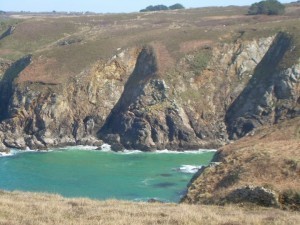 The mauritian slaves had their place of freedom, so where is mine ? Before writing this, I was pretty sure that this particular beach with the view of the Morne mountain was it. But it’s not. As I was thinking about my next words, I suddenly realised that my place of freedom is simply the seaside. It doesn’t matter where it is. It could be in Mauritius, where I love spending time, it could be in Ireland , where I live, or it could be in Brittany, where I’m from. I love the sea and couldn’t live without it. I love walking down the beach in my small irish village when the wind blows in my face and clears my thoughts. I love storms and watching the waves crash on the rocks in Brittany. It reminds me that we are so small in this immensely big ocean. I also love the serenity of the mauritian lagoon, especially in the morning, when the beach is empty and all I can hear are the little wavelets coming up and down the shore. I don’t need to go to the sea everyday, I just have to know it’s there, accessible if I want to.
The mauritian slaves had their place of freedom, so where is mine ? Before writing this, I was pretty sure that this particular beach with the view of the Morne mountain was it. But it’s not. As I was thinking about my next words, I suddenly realised that my place of freedom is simply the seaside. It doesn’t matter where it is. It could be in Mauritius, where I love spending time, it could be in Ireland , where I live, or it could be in Brittany, where I’m from. I love the sea and couldn’t live without it. I love walking down the beach in my small irish village when the wind blows in my face and clears my thoughts. I love storms and watching the waves crash on the rocks in Brittany. It reminds me that we are so small in this immensely big ocean. I also love the serenity of the mauritian lagoon, especially in the morning, when the beach is empty and all I can hear are the little wavelets coming up and down the shore. I don’t need to go to the sea everyday, I just have to know it’s there, accessible if I want to.
We are all slaves of something: our job, our responsibilities, our emotions, our smartphone… But when I look at the ocean, I forget everything. It calms me down, it gives me strength, it makes me laugh, it makes me cry. It makes me feel at peace with myself.
We say “water is life”, I say “The sea is where I feel alive”.
About the Author: My name is Anne, I am French but I’ve lived in Ireland for the past 11 years. That’s where I met my husband, who is from Mauritius. I’ve been to his country a few times and I loved it so much that I created a blog about it.
The post Mauritius: Somewhere on the seaside appeared first on We Said Go Travel.
New Hampshire: Live Free and Eat
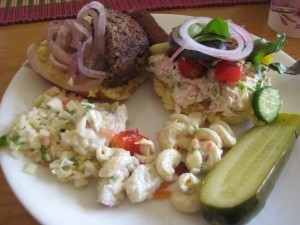 New Hampshire: Live Free and Eat
New Hampshire: Live Free and Eat
I never really thought about what New Hampshire’s state slogan, “Live Free or Die”, really meant to me. Perhaps it is the epitome of good memories and feelings I have from over 25 years of trips to Lake Winnipesaukee a.k.a. The Lakes Region.
I am not there this July 4th Independence Day and miss the food, friends and family. New Hampshire being a place where you don’t have to wear a helmet to ride a motorcycle. That may constitute freedom (or stupidity as a former motorcycle rider who once needed one). My mind flashes back to moments in time. All those days swimming in the pristinely clean water, sun bathing on the floating dock, jet skiing or jumping off a boat deck.
On the flip side my stomach remembers old-fashioned beef jerky from the jar at the local family owed grocery store down the winding country road (now sadly replaced with some less tasty plastic wrapped version). The traditional fried dough (a circle of deep fried dough doused in powdered sugar on a paper plate) at the place that doubles for a greasy pizzeria (same paper plates) by arcade alley at Weirs Beach, the honky-tonk strip with quintessential bumper cars, penny arcades, souvenir and T-shirt shops.
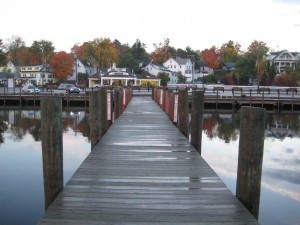 I wonder did I feel free because I was a kid and had less worries or independent because with my pocket full of tokens I could roam around Funspot (one of the world’s largest arcades) and choose whatever game I wanted. Better still, sleeping until whenever I was ready for brunch at the Village Kitchen (which hasn’t changed a bit in years). The big breakfast is still heartily called “The Farmer’s” with thick cut ham, sausage, bacon, baked beans, grilled potatoes, fresh toast and jam, plus a bottomless ceramic mug of diner style coffee or orange pekoe tea (which I usually sub in). A meal like that usually filled us up until about 3:30pm when it was time for another typical lakeside attraction, a hand scooping ice cream parlor.
I wonder did I feel free because I was a kid and had less worries or independent because with my pocket full of tokens I could roam around Funspot (one of the world’s largest arcades) and choose whatever game I wanted. Better still, sleeping until whenever I was ready for brunch at the Village Kitchen (which hasn’t changed a bit in years). The big breakfast is still heartily called “The Farmer’s” with thick cut ham, sausage, bacon, baked beans, grilled potatoes, fresh toast and jam, plus a bottomless ceramic mug of diner style coffee or orange pekoe tea (which I usually sub in). A meal like that usually filled us up until about 3:30pm when it was time for another typical lakeside attraction, a hand scooping ice cream parlor.
A memoir about such a place could not be complete without an ode to one of my favorite lobster roll joints in New England. The Tamarack Drive-In, still serving up a very expensive butter toasted roll stuffed with a blended filling of lobster meat, mayonnaise and a hint of chopped celery. Granted the quality and quantity of lobster filling has gone up and down over the years, but it’s really that feeling of pure joy and then a whole lot of “full belly” that makes the cost easier to swallow. As for that ode, my cousins and I sang this as kids, “Tamarack food, it’s bad, it’s slow, Tamarack Drive-In way to go!” Lyrics aside, we couldn’t wait for an outing around the lakes ring road for such a treat.
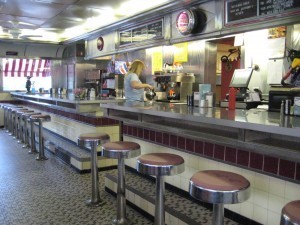 On special occasions (or when the economy was better), fried clams and scallop platters with mountains of onion rings were added to the order and of course polished off with large Root beers (or an ice cream float version for good measure). I’ve heard they have other items on the menu, but don’t ask me about them. Honorable mention goes to Sawyer’s Dairy Bar & Restaurant which serves up their lobster roll with extra creamy coleslaw. The debate continues to rage on about which is the best, so before that gets ugly, I’ll press on with my musings.
On special occasions (or when the economy was better), fried clams and scallop platters with mountains of onion rings were added to the order and of course polished off with large Root beers (or an ice cream float version for good measure). I’ve heard they have other items on the menu, but don’t ask me about them. Honorable mention goes to Sawyer’s Dairy Bar & Restaurant which serves up their lobster roll with extra creamy coleslaw. The debate continues to rage on about which is the best, so before that gets ugly, I’ll press on with my musings.
Between all this eating and craving of lakes region grub, there was some time made for mini-golf. I once scored a hole-in-one which cancels out the “odd” lost ball. I recall a carved wooden sign out front that when looked at a certain way was not G friendly (it’s long since been torn down). A quarter mile down the road was one of the two local places for Go-Karting. Anyone will tell you that driving before you have a license is a joy of joys, whether it be a Golf Kart or a moped on private property. Go-Karts were best because you could race someone like your Dad or Uncle who had a real license and win.
One final thought that pops into my now giddy mind is of the old water park – Surf Coaster. Freedom on a suspended waterslide is about the most liberating experience I can remember. No seatbelt, no speed limit, just you and your shoulders against what we fondly re-named the Surf Toaster (a little cliché, it is now business toast).
Can you tell I am much more into the live (I live to eat) part of the state slogan. Did I mention the diners and eat at home BBQ nights? Slogan or not, freedom to me is a fresh lobster roll on a midsummer’s eve in New Hampshire by the lake.
About the Author: Jeff Shoer: Having traveled the earth in search of a happy stomach. Jeff continues to follow a path to food loving destinations. He hopes to walk off the calories en-route to more great tastes.
The post New Hampshire: Live Free and Eat appeared first on We Said Go Travel.
July 15, 2013
Myanmar: Bagan Day One (video)
WATCH: 24 Bagan Day One, Myanmar (Burma)
This movie is one of 45 movies from our 27 days in Burma in October 2012.
On our first night in Bagan, we walked from Winner Guesthouse to see Hilo Milo at night. It was spectacular at night and we loved that the shopping was closed and there were no crowds.
On October 10, we had our first day biking in Bagan. I read about the temples and told the others about the Indian and Sri Lanka influences, the three main hand positions of Buddha and how in India they built in stone, but in Bagan with bricks with stucco over. We were able to see all of the hand positions as well as where the bricks were showing through from under the stucco. We also looked for the ceiling paintings with one thousand Buddha images.
Today we saw: Lawka chanthar phaya, Thagyar hit phaya and Thagyarpone phaya
A few tips: wear shoes you can easily slip off and bring a flashlight. Certain temples are dark and if you decide to go to the upper level in any of the temples the staircases are narrow and quite dark.
Eat at Pyi Sone Restaurant on the main road between Old Bagan and Nyuang U. The food is good and the team including Ko Myo, Ma Swe and Jo Jo are amazing. (perfectpyisone@gmail.com) More about this day on www.wesaidgotravel.com
This movie is from our 28 days in Myanmar (Burma) from September 28, 2012 to October 26, 2012 and our year TRIP in South East Asia, see all the videos from our trip.
Just out July 2013:
OUR MEMOIR, TRAVELING IN SIN , IS AVAILABLE AT AMAZON.COM.
The post Myanmar: Bagan Day One (video) appeared first on We Said Go Travel.
Pakistan: The Magical Valley of Naran
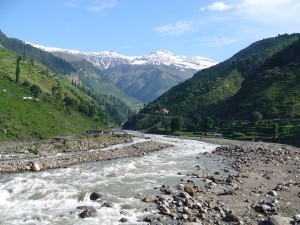 It was five in the morning and the soft sun beams had slowly started transcending over everything, bringing to life the amazing manifestations of natural beauty that were plunged in darkness a while ago. The black sky that was adorned with shining jewels at night gradually turned awesome as the Creator brushed it with hues of yellow and orange out of His palette.
It was five in the morning and the soft sun beams had slowly started transcending over everything, bringing to life the amazing manifestations of natural beauty that were plunged in darkness a while ago. The black sky that was adorned with shining jewels at night gradually turned awesome as the Creator brushed it with hues of yellow and orange out of His palette.
Covered by canopies of fresh white snow, the majestic mountains in the midst of which I had spent the night awed me. I lay in my sleeping bag; listening intently to the silence that invades this valley at night, except for the sound of running river far away. Never had I witnessed such calm and peace. I got up, rolled my sleeping bag and went inside the camping tent to freshen up.
It was our second day in the magical valley of Naran, 276km north of Islamabad and still it was hard to believe that nature could be so beautiful, so divine. Surrounded by lush green landscape, gigantic mountains, glaciers that dazzled like white gold as the sunlight reflected from them all seemed so magical. My family had been up till late last night so I decide to take a morning walk alone and fill my lungs with the fresh morning breeze for a change.
The familiar sound of churning metal wheel on the bank of River Kunhar was now clearly audible in the stark silence. “It sure needs to be oiled,” I thought. It was a sign that the day had already begun in Naran Valley and the locals were off to work. Local people cross river Kunhar by taking a ride on an iron carrier I call the “air boat.” Two laborers standing on the other side of river turn a big wheel together to wind the metallic rope suspended above water around a pulley to pull the carrier.
As I took a trail uphill, I could not help but marvel at the trekking skills of the people and cattle dwelling in the valley. The trails are no more than three feet wide, making it difficult for two people to walk together. Some children clad in their traditional dress “shalwar kameez,” (long knee length shirts with quite baggy trousers) had come out of houses to take their cattle for grazing .I watched them with amusement as they ran up and down the lush green steep hills chasing their pets. Three women carrying huge stacks of wooden logs on their head were walking down the river. The wood was tied with some old tattered traditional floral shawls. The people of Naran lead a hard life. In absence of electricity, the locals burn wood to generate heat for cooking and keeping themselves warm. Sometimes the roads here may get blocked due to land sliding, thus hindering the transport of supplies to the valley.
Feeling a bit exhausted from climbing, I descended towards river Kunhar whose clean water appeared milky white due to the strong current hitting rocks forcefully. It made a loud whooshing sound. I located a safe spot on the river bank and took off my joggers to plunge my feet in the chilled water. The sky was now bright and beautiful and chirping of birds was clearly audible. Far away I could see fisher men approaching the river bank with net and fishing rods to hunt Naran’s famous trout. While I leisurely splashed the running water with my feet, far away I noticed a tourist fixing a traditional wooden bed woven with ropes called charpai in the middle of a stream with the help of rocks. Curious, I watched intently as a woman handed him a basket of ripe mangoes and the man fixed it in the water too. I could not help but smile and appreciate their idea of chilling fruit and enjoying cool river breeze on a charpai.
Suddenly I spotted a child, around eight years of age plucking white daisies to make beautiful garlands for tourists. Ignorant of their low standard of living, which almost touches the poverty line; those little children’s sparkling eyes and smiling faces appeared so peaceful. And I wondered, what have they to lose anyway. They live so close to nature, eat pure organic food and keep fit by walking miles each day. It’s us who have become so used to city life that there is no escape now. But Naran is a place that makes me feel free. An escape from the stress of city life, a hide out from the scorching sun and long hours of load shedding, here I feel free like a bird. Free from the hustle and bustle of city, the honking horns and the running clocks. I am in eternal bliss. I am in the valley of Naran, North Pakistan.
About the Author: Iram Moazzam is a budding writer with a degree of Masters in Human Resource Management. She aspires to become a travel writer and explore every corner of the world. She can be found on Facebook.
The post Pakistan: The Magical Valley of Naran appeared first on We Said Go Travel.
Himalayas: Devi Darshan
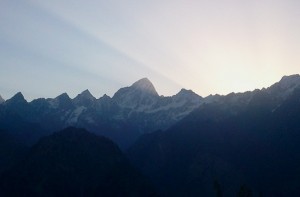 It had rained all through the night and though the dawn opened dull and damp, as the morning gained momentum, the mood of the mountain improved substantially.
It had rained all through the night and though the dawn opened dull and damp, as the morning gained momentum, the mood of the mountain improved substantially.
The steep rise to the ridge through a bridle path bordered with prickly bushes and punctuated by silvery streams had taken a toll on my city-bred system used to elevators and escalators. But after reaching the vantage point, as I lay on a small patch of rain-fed green on the shoulder of the hill, the accumulated exhaustion, simply evaporated. Soaking in a sea of stillness and serenity, I was slowly rediscovering my robbed energies as around me the seconds ran, the minutes jogged and an hour absentmindedly ambled along.
Centuries-old maples swayed and softly spoke to each other, their voices rippling over me like a mountain stream. And in the in-between spaces, a momentum less breeze, drugged with unseen droplets sleepily dragged itself from tree to tree, carrying the messages.
The sky was a milieu of brilliant blue and resting against it were some of the highest peaks on the planet, for a view of which I had willingly undertaken the 40-hour long tedious journey from the plains to the high altitude Himalayan hamlet of Lata, nestling in the shadow of the eternal snows.
“Didi (sister) look! That is Nanda Devi, our Mother Goddess!” Birju, my guide, suddenly gushes as he points towards a cloud-veiled proud pinnacle, the colossal façade glowing golden in the nascent sunshine.
“The clouds are chayya mayya – a magic veil meant to protect her from the onslaught of sunlight. It is only the blessed few who get a glimpse of her bare face.” His voice reinforced with firm belief, rings in my ears and slowly seeps into my soul.
Here in the Himalayas, the peaks are more than just a juxtapose of rocks and snow, but ancient aspirations divinized. The Nanda Devi is regarded as the female manifestation of the supreme Shakti or power. In the entire region, the lives of Birju and others like him revolve around the dictates of the Devi -one of which conditions men to look upon the gentler gender as mortal extensions of the goddess- to be nurtured and revered, not objects of lust to be taken advantage of in moments of weakness. And right now even though it is only the two of us at the lonely mountain top and the nearest human habitat is 5 kms away, I don’t feel one bit unsafe.
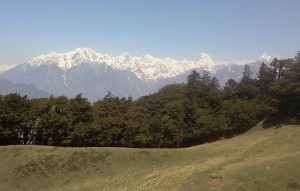 Life in an Indian metro for a single working woman, though appears lucrative to many, is actually akin to walking a tightrope. To the nosy neighbours, I am a suspicious character, dwelling outside the standard boundaries of the society. And at workplace, the attitudes of most male colleagues make me feel as if I am carrying a tag “available.”
Life in an Indian metro for a single working woman, though appears lucrative to many, is actually akin to walking a tightrope. To the nosy neighbours, I am a suspicious character, dwelling outside the standard boundaries of the society. And at workplace, the attitudes of most male colleagues make me feel as if I am carrying a tag “available.”
But up here in the mountains, I feel truly liberated, and close to God. The people, especially the men folk, engage but don’t intrude, their concern for my well- being overrides the initial curiosity about my coordinates and companions, or rather lack of them.
“Didi, see over there!” as Birju calls out, I turn west and shiver in ecstasy, for the spectacle that enfolds before me is magic, sheer magic.
The playful clouds have shifted position and gone after the sun, liberating Nanda Devi who now lifts her veil and gives me a darshan (view of the divine) of her full glory.
A pyramid of pristine white, the pinnacle dyed a dying rose and totally untouched by the miseries that grovel at her feet. The very sight lifts the soul to limitless heights and unknowingly, the trivialities and drudgeries of daily existence pale into insignificance.
With a cleansed and healed mind I effortlessly touch the tune of eternity, the experience and understanding of which I hope will remain with me after I descend from the attained heights into the dusty drop of the plains where I know I have to return.
About the Author: Sriparna Saha: An architect and travel writer who loves to draw pen pictures more than plans and perspectives.
The post Himalayas: Devi Darshan appeared first on We Said Go Travel.
July 14, 2013
Rediscovering Freedom in North Korea
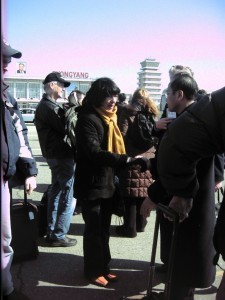
THE PRESS ON THE AIRPORT TARMAC
North Korea and freedom. Do they belong in the same sentence? One would think not. Yet, the time I spent there could not have better illuminated what independence and freedom truly mean. In 2008 I had the good fortune to spend 48 hours in Pyongyang performing with the New York Philharmonic. As an American traveling in North Korea, safe in the knowledge that I would soon return home to the United States, never have I been so reminded of the gifts that we have in the free world.
During the flight to Pyongyang, our cell phones were taken from us. Thus began the quick transition from a life of independence and freedom, to a place where these concepts are anathema. As the South Korean chartered jumbo jet started to descend towards Pyongyang airport, what struck me most was the distinct lack of color. The browns of the North Korean winter landscape were complemented by the equally bland grays of the military planes that were parked on the tarmac. The bleak landscape truly gave one the impression of having stepped back in time. As we drove into the city of Pyongyang, that image was strengthened.
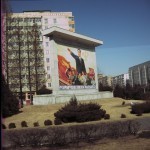
MILITARY BILLBOARD IN PYONGYANG
There seems to be little commerce on the streets of Pyongyang. There are few cars. Most people travel by bike or on foot. At night, the city is eerily dark. Satellite images of the Korean Peninsula at night show a brightly lit South and a North that is practically black. I would venture to say that progress has been halted for everything that benefits the human condition. This is a heavily militaristic society. The people and their humanity is not a priority. As these impressions filled me, I was once again reminded that I would soon be returning to my home, where freedom is a right we strongly value and possess.
We were housed in the nicest high rise hotel in Pyongyang. When the hotel elevator doors opened, the floors were dark and cold. However, the floors that the orchestra resided in were bright and toasty warm. In fact, our rooms were obscenely overheated. The image of sweating Americans trying to pry open their hotel room windows during a cold February day in North Korea is striking. The meals served were embarrassingly lavish. All of this gave the sense that they were trying too hard to make a positive impression, to fool the Western world about the terrible truths of life in North Korea and to create a false image of a prosperous life in this most unprosperous place. In the United States there are rich and poor, But those with less have the freedom to elevate their status. I suspect there are no rags to riches stories in North Korea. The vast majority of these people are dirt poor with no hope of improving their lot in life. The image that was being presented was all smoke and mirrors. The absurdity of the illusion would be laughable if it wasn’t for the tremendous human suffering that was being obfuscated.
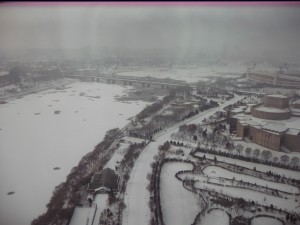
PYONGYANG FROM ABOVE
The people that accompanied the orchestra during our stay were called minders. More than one of these people explained to me that it was South Korean’s intention to reunite with North Korea, and that Pyongyang would be the seat of power in this unified country. One needs only to spend five minutes in Seoul to realize the absurdity of this statement. I kept waiting for a sign, a wink of an eye, something to let me know that they knew the real truth. That sign never came. They either truly believed what they were saying, or were far too afraid to say otherwise. Speaking against the state can result in death for the perpetrator and his family. This can create the kind of fear that is the mirror image of the complacency that freedom has brought us in the United States.
The orchestra played a beautiful and moving concert, and the reception was extraordinarily heartwarming. Hundreds of articles were written about this historic event. Never had a group of Americans this large been in North Korea since the Korean war. It was considered remarkable that so many foreign journalists were allowed to accompany the orchestra, and even more remarkable that a live broadcast was permitted. Perhaps this concert could have marked the beginning of
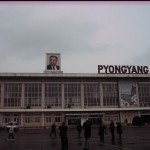
PYONGYANG AIRPORT
improvement in this repressive land, but unfortunately, North Koreans are no better off than they were 5 years ago. I am eternally grateful for the opportunity to visit this country and its people, but am deeply saddened that 5 years after my visit, change seems nonexistent. Getting a glimpse of this place, trapped in the bonds of repression and fear, nothing could make me more grateful for the freedom I enjoy as an American today.
About the Author: David W. Smith is a professional musician, and has been playing in the orchestras of Broadway shows for almost 30 years. He is currently a member of the “Phantom of the Opera” orchestra. and is also a frequent performer with the New York Philharmonic. He has travelled extensively both for work and pleasure. Find David on Facebook.
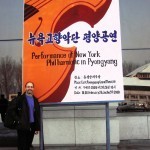
THE AUTHOR IN PYONGYANG
The post Rediscovering Freedom in North Korea appeared first on We Said Go Travel.
We Said Go Travel
We Said Go Travel is a global community of over sixteen hundred writers with articles from every continent.
Stories are shared with photos and video from a perspective of the transformative power of travel. We Said Go Travel has hosted live and online events as well as travel writing contests around the world. ...more
- Lisa Niver's profile
- 57 followers



